#Clinopodium vulgare
Text



wild basil..
an interesting "easy to grow" introduced plant...a tiny patch appearing out of nowhere...
155 notes
·
View notes
Text
My Garden Flowers Part 2
All photos mine. The narrow-leaved sundrops photo is edited for colour since the camera apparently can't reproduce that intense of a yellow. Neither can any Photopea editing, but at least it's closer. It's the bright of highlighter yellow but more golden.























In order of appearance:
031. Philadelphia fleabane (Erigeron philadelphicus) A welcome "weed" I couldn't find available at any of the native plant places in Ontario (one in Manitoba carried it but it wasn't available) but she planted herself.
032. Canadian Lettuce (Lactuca canadensis) Another welcome "weed" that sadly didn't manage to reseed, but maybe one will turn up again.
033-034. Jack-in-the-Pulpit male and female flowers (Arisaema triphyllum) The male has one leaf set while the female has two. The babies only have a leafset and no flowers for the first couple years of their lives. Then they reach sexual maturity as males, the next year they'll be female and switch back and forth until the end of their lives.
035. Early Meadow Rue (Thalictrum dioicum) Not pictured as she hasn't flowered yet. She's new. Hopefully next year.
036. Creeping Oregon Grape (Mahonia repens) First they gave me a non-native cinquefoil but thankfully rectified it by giving me two of these when I'd only ordered one. They've flowered before, but never so profusely as they both have this spring, and there are a number of berries ripening! They also made a baby from previous years, or else one of them suckered.
037. Three-Leaved Coneflower (Rudbeckia triloba) So...I planted her. She died. I swear she died, like root and all, she did not make the winter. Didn't come up in the spring. But now she is in several places! Managed to reseed herself? Perhaps. I don't recall that she flowered the year I planted her. Had dormant seeds in her pot with her? Coincidental present from squirrels? Either way, she's roughly in the spot I wanted her and is flowering well. Who cares how she got there?
038. Witherod Viburnum (Viburnum nudum cassinoides) Not pictured as she hasn't flowered yet. Hopefully next year!
039. Purple Milkweed (Asclepias purpurascens) Not pictured as she hasn't flowered yet. She's a new milkweed species for me! If she makes it through the summer and then the winter I should have more flowers to post in a year or two. :)
040. Rosy Pussytoes (Antennaria rosea) Not pictured as she hasn't flowered yet. Surviving, though, which is saying something because not even weeds grow there. It's a very dry spot and I've been kind of neutred from watering. But I read that she likes dry and that spot is dry. So good luck to her.
041. Prairie Alumroot (Heuchera richardsonii) Not pictured as she hasn't flowered yet. Also surviving in said very dry area.
042. Ramps (Allium tricoccum) I really hope her seeds made baby ramps! They only flower after reaching maturity at seven years, which is why it's bad when people come and uproot the lot of them. And I mean, they taste nice but not where I understand why people do that.
043. Spicebush (Lindera benzoin) My native allspice substitute! Her berries are currently developing and will be red in the fall. Still hoping to attract spicebush swallowtails one day.
044. Bigleaf Lupine (Lupinus polyphyllus) Was supposed to be sundial lupine but definitely isn't. There is disagreement between VASCAN and the USDA over whether there is a single variant of one subspecies of L. polyphyllus that's native to Ontario. This one stays in my garden until that's settled. Anyway, she's a gorgeous plant but the reason to avoid intentionally planting it in Ontario is that it easily hybridizes with sundial lupine. The hairstreak caterpillar can only eat true sundial lupine leaves. I don't know if the variant that the USDA says is native is a misidentified hybrid (bad, but also doesn't seem like it because the variant listed by the USDA is Lupinus polyphyllus ssp. polyphyllus var. polyphyllus) or just a well-behaved variant (fine, just like there's a native subspecies of Phragmites australis). But again, I'll be leaving mine in until I learn for sure, and I won't be planting sundial lupine there to avoid hybridization.
045. Sweet Joe-Pyeweed (Eupatorium purpureum) Fuzzy flowers! She can get very tall. I'm also finding out she's a slow spreader as there is an individual nearby that I didn't plant.
046. Tall Bluebells (Mertensia paniculata) She survived several years and seemed to do well, but she didn't come up this spring. I'll need to get another one and try a spot that's not quite so tough.
047. Poke Milkweed (Asclepias exaltata) Not pictured as she hasn't flowered yet. But this is her second year, so to judge by some of my other species she should do it next year!
048. Narrow-Leaved Sundrops (Oenothera fruticosa) No flowers I've seen are as intensely yellow as those in this genus, and narrow-leaved sundrops and evening primrose in particular seem to just glow.
049. Cup Plant (Silphium perfoliatum) The coolest part of this plant is in the name: the bases of her leaf stalks wrap around the flower stalk to make cups at the joints. Water settles there and birds come to drink. I haven't seen this happen yet, but I'm waiting. The flowers, however, are quite sizable, very pretty, and attract lots of bees. She gets tall like some common sunflower cultivars.
050. Canada Violet (Viola canadensis) She barely came back this year after doing well for several. I think it was just a dry winter, but the point is for them to be able to survive all seasons any year, so I'm going to try somewhere else.
051. Stinging Nettle (Urtica gracilis) I'm assuming, anyway. She planted herself in my garden at my former apartment and I potted and took her with me when I moved. She's been doing okay. And bitey. She's very bitey.
052. Zigzag Goldenrod (Solidago flexicaulis) I didn't plant that, so free native plant for me! She's also made babies.
053. Cutleaf Coneflower (Rudbeckia laciniata) Finally flowering this year!
054. Lowbush Blueberry (Vaccinium angustifolium) Not pictured as I haven't got pictures yet.
055. Highbush Blueberry (Vaccinium corymbosum) A cultivar, though I can't remember which. I try to avoid cultivars and get the wild type if I can, but it's not always possible and not all cultivars are bad.
056. Lance Selfheal (Prunella vulgaris lanceolata) Selfheal is a common garden weed but unobtrusive and makes cute purple flowers. Not to mention edible and medicinal uses! This one is the subspecies native to Ontario proper, whereas her close cousin is common up here but apparently only native to the northeastern United States bordering southern Ontario.
057. Dense Blazing Star (Liatris spicata) She's fuzzy. She's magenta purple. Bees love her. She's perfect.
058. Fairy Candle (Actaea racemosa) She's related to the baneberries and is herself poisonous but she does have some limited edible uses. And her delicate white flowerheads are lovely.
059. Star-Flowered Onion (Allium stellata) So glad I was able to get her before the place that sold her stopped shipping to my province. No one in my province carries this! But she is native, I have her, and she is an ever green plant that simply resumes growth as soon as the snow melts.
060. Wood Violet (Viola sororia) Other than V. odorata, which is invasive in North America, if you see the classic blue, purple, and white violets growing everywhere in the spring in North America it's probably this species. Yes, violets can actually be blue! Not the sky blue of forgetmenots, dayflowers, or bluebells, or the deep blue of lobelias, but blue.
#blackswallowtailbutterfly#my photos#photography#my garden#garden flowers#native plant gardening#native flowers of Carolinian Canada and USA#Erigeron philadelphicus#Lactuca canadensis#Arisaema triphyllum#Clinopodium vulgare#Mahonia repens#Rudbeckia triloba#Allium tricoccum#Lindera benzoin#Lupinus polyphyllus#Eupatorium purpureum#Mertensia paniculata#Oenothera fruticosa#Silphium perfoliatum#Viola canadensis#Urtica gracilis#Solidago flexicaulis#Rudbeckia laciniata#Vaccinium corymbosum#Prunella vulgaris lanceolata#Liatris spicata#Actaea racemosa#Allium stellata
11 notes
·
View notes
Photo

Wild Basil
Clinopodium vulgare
Lamiaceae
Photograph taken on June 20, 2023, at Petroglyphs Provincial Park, Woodview, Ontario, Canada.
#wildflowers of southern ontario#wild basil#basil#purple#Clinopodium vulgare#Clinopodium#Lamiaceae#Petroglyphs Provincial Park#Woodview#Ontario#Canada#wildflowers#flowers#wildflower#flora
40 notes
·
View notes
Note
time to dump a whole bunch of clanmew translations on you!!!!
Stemcurl- Prryemarreoopa, this is a really long one but I really like saying it for some reason. I imagine they would get a nickname like Squilf, but I could not for the life of me figure one out lmao
Dropletbreak- Kipimkerroch, technically this should probably be translated as Dropletshatter, but I prefer -break! it's meant to evoke that very first raindrop that splats right on your nose and makes you think 'well. it's definitely going to rain.'
Lightflood- Anelalm, there's not a specific word for flood, but I think -wave works pretty well here!
Basilsnap/star- Mwelkaygurga/Mwelshai, so apparently basil doesn't grow naturally in the UK??? you learn something new every day, I guess? anyways I just replaced it with spearmint, since it's in the same family and looks at least a little bit similar.
Shadedance- Horrlshigashig, the 'danced' here isn't exactly what I wanted? I was looking more for a 'trembled/swayed,' since his name is supposed to be like the shadows of leaves on the forest floor, but I couldn't find anything in the 'movement' semantic field...
Flickerfate- Swarfssamep/Swarforrmep, these (to me) would be translated the same way in English, but they have very different meanings. 'fate' as a suffix is a bit of a weird one, but it was originally granted as an Honor Title due to their affinity to see omens in fires; it eventually turned into a Dishonor Title for fun story reasons that I won't bore you with lol.
Nacreclaw- Solyskkachit, this one is... interesting. There's no word in Clammew for nacre (probably because they don't live by the sea and wouldn't see it), so I attempted to combine 'solyss' and 'sek' into a sort of compound word, and ended up with 'solysk,' so, there we go?
Oh I love these, absolute MVP goes to Dropletbreak, that's such a neat image! On Prryemarreoopa, I think that a good nickname would be Prryoo. It takes a piece from both the prefix and suffix, and keeps that "fun to say" vibe from the full name.
New words;
Flood = Worrl
Translates directly.
(Note: a syke, mawss, is a stream that floods seasonally.)
Basil (Clinopodium vulgare) = Pomba
(Heart + Flower)
An important astringent, used to speed up heartrate, help a cat cough up phlegm, and even treat mild infection. In times of excess, it's even used for making yellow dye! Has orchid-like, delicate little purple flowers.
You were probably looking at the wrong type of basil! Basils in the family Ocimum (such as sweet basil) don't grow in the UK, this is the historic type of basil used as medicine.
Plant Movements
I think I see what you're looking for with Shadedance, and this is a good area to expand in I think. I'm going to give you a bunch of words for the movement of plants, from the perspective of Clan cats.
Twanged/Twanging/Will Twang = Ookooau/Ookooa/Ookoo
SPECIFICALLY the unnatural movement a plant makes when an animal interacts with it. It's the tremble of a branch as a squirrel runs on it, or the bow of a flower when a fat bee grabs it, or the spring of a twig that a sparrow perches on. A plant that is bearing the weight of a creature.
Rolled-Together/Rolling-Together/Will-Roll-Together = Shalalshe/Shalashe/Shalshe
AN IRREGULAR STEM, watch out!
The wave-like movement of wall grass as it bends with the wind. Also used metaphorically, for when you ALL move together. "SHALSHE!" is a full sentence on its own, a command, that the entire group you're referring to should move as one.
Sway = Hayyssassa/Hayyssass/Hayyssa
The gentle movement of plants in wind.
Tattled/Tattled/Tattling = Cha'ha'hach/Cha'ha'ha/Cha'ha
The odd, irregular dancing of rain or hail on leaves or roofing. Like English, this word can also be used for "telling on someone" or "giving something hidden away," because you may not know it is raining except for the tattle of the den above you.
Also used by tunnelers when they could tell something was above them, based on the sound of pawsteps.
Rattle = Shewshioo/Shewshi/Shewsh
The violent shaking of leaves and branches under high winds; arbitrarily different from "sway" from the fact that it makes listening difficult and stops the singing of birds.
Collapsed-Swayed/Collapsing-Sway/Will-Collapse-Will-Sway = Goorraoa/Goorrao/Goorra
WHEN THE WIND IS SO STRONG IT'S MAKING THE TRUNKS GROAN. VERY powerful word, because it will also describe the sway of the roots in the ground as they're pulled by the tree. The ground might literally dance. Also applied emotionally to a cat whose "world is shaken," swaying as if they might collapse, from news so powerful it's making them dizzy.
I don't know how to put the power of this word into English so I just made it red lmao. The grass it-bows-together, the oak it-collapes-sways. I would use this for Honor Titles.
Rustle = Kish
The sound plants with leaves make when shaken. Compare to Russ, the word for leaves AND the sound they make when wind gently passes through them. A bonus for you.
#Clanmew#DANCING around being straightforward with dances for now#Simply because I am actually really impressed and amused with how people translate it when Shigashig doesn't quite fit#I find it's actually a constriction on creativity that really pays off#People will describe it as swirling. Or jumping. Or skipping...#And in a way that's even more beautiful than straightup like giving a word for jigs vs gavots#I might add them at some point but at the moment I am actually very much enjoying seeing what people come up with#And am trying to add more interesting Clanmew verbs that don't even have equivalents in English
38 notes
·
View notes
Text

C – Clinopodium vulgare L. – Clinopodio dei boschi (Lamiaceae)
51 notes
·
View notes
Link
1 note
·
View note
Link
1 note
·
View note
Text

Not 100% certain due to slightly blurry photo, but I think this is Clinopodium vulgare, wild basil.
#Bruce Trail#Peninsula Section#Niagara Escarpment#Bruce Peninsula#Bruce Peninsula National Park#National Park#Bruce County#Ontario#Canada#Great Lakes#Georgian Bay#Lake Huron#hiking#hiking trail#Halfway Dump to Crane Lake#photography#forest#outdoors#Clinopodium vulgare#wild basil#flora#plant#vegetation#flowers#blossoms#digital photography#DSLR#Canon 6D#photographers on Tumblr
0 notes
Text

gewöhnlicher Wirbeldost
(Clinopodium vulgare) wochenlang blüht mal hier, mal da eine einzelne Blüte. Fotogen ist anders. Auf unserer trockenen Wiese wächst er überall.
Noch 34 Pflanzen.
0 notes
Text
Ancient Hellenic Herbs, O-Y
[Introduction & Index]
Oak (Drys)
Species: Quercus ilex
Identification: A tree with brown bark, medium to large green leaves, and distinctive nuts (acorns)
Associations/Uses: Zeus, oracle of Dodona, Dryades, Byblis, the Golden Fleece, Balanos, Arkadian tribes, strength
Olive Tree (Elaia/Moria)
Species: Olea europaea
Identification: A greyish green tree with green to brown fruit
Associations/Uses: Athene, Athens, Zeus, Moria (maiden), victory, Olympian Games, cooking, lamplight, lotion
Opium Poppy (Mêkôn)
Species: Papaver somniferum
Identification: A bright red flower with a black center and small, round black seeds
Associations/Uses: Demeter, Hypnos, sleep, opium, sedation, Mekon (youth)
Oregano (Agrioriganos)
Species: Origanum vulgare
Identification: A sprawling herbaceous green plant with pink or purple flowers
Associations/Uses: Luck, joy, Aphrodite, healing snakebite, marriage
Parsley/Wild Celery (Selinon)
Species: Petroselinum sativum & Apium graveolens respectively
Identification: Parsley and celery were equated by the Ancient Greeks
Associations/Uses: Death, victory, a victor’s wreath, Poseidon, Zeus, Isthmian Games, Nemean Games
Pomegranate (Rhoa)
Species: Punica granatum
Identification: A tree with glossy green leaves and distinctive red fruit
Associations/Uses: Persephone, the underworld, women, fertility, childbirth, astringent, Aphrodite
Rock-Rose (Kisthos)
Species: Cistus incanus
Identification: Low growing shrub with large yellow or pink flowers
Associations/Uses: Poseidon, Medousa, aphrodisiac, incense, treating menstrual problems
Rose (Rhodon/Rhodinon)
Species: Rosa gallica
Identification: A thorny shrub with red, white or pink flowers
Associations/Uses: Aphrodite, Adonis, love, passion, beauty, abduction of Kore, Eros, happiness, astringent, treating headaches
Rosemary (Aposplēnos/Dendrolibanon)
Species: Rosmarinus officinalis
Identification: An aromatic shrub with needle-esque leaves and sometimes purple, white, pink, or blue flowers
Associations/Uses: Funerary rites, studying, memory, protection, health
Rough Bindweed (Smilax)
Species: Smilax aspera
Identification: A spiky climbing vine with red berries and pale green flowers
Associations/Uses: Smilax (nymph), Dionysos, Dionysian orgies
Strawberry Tree (Komaros/Andrakhnos)
Species: Arbutus andrachne & Arbutus unedo
Identification: An evergreen tree with edible, round red fruit, and bell shaped flowers
Associations/Uses: Hermes
Walnut (Karya Basilika)
Species: Juglans regia
Identification: A tree with nuts that have a distinctive wrinkly shape
Associations/Uses: Karya (maiden), Dionysos, treating poison, treating dislocations, anti inflammatory, Artemis, prophecy, Katyatides (nymphs)
Wheat (Pyros)
Species: Triticum vulgare
Identification: A tall food crop with green shoots topped with seeds, golden when ripe
Associations/Uses: Eleusinian Mysteries, Demeter, agriculture
Wild Basil (Pyknokomon/Klinopodion)
Species: Clinopodium vulgare
Identification: An edible plant with pointed and toothed oval leaves, square stem, and purple flowers
Associations/Uses: Treating convulsions, venom antidote, anti inflammatory, protection, death
Wych Elm (Ptelea)
Species: Ulmus glabra
Identification: A tall tree with oval leaves
Associations/Uses: Dionysos, Haides, graves, dreams, Eetion, Hesperide Erytheia, Ptelea (nymph)
Yew (Smilos/Milos/Taxos)
Species: Taxus baccata
Identification: A reddish-barked conifer with needle-like leaves and bright red berries
Associations/Uses: Erinyes, Hekate, nekromankia, purification, death
#pharmakeia#pharmakis#hellenic paganism#hellenic polytheism#hellenismos#green witch#hellenic herbs#greek mythology#ancient greek#magik#herb
87 notes
·
View notes
Photo










I’ve really come to appreciate and cherish the wildness and solitude of Snake Wildlife Management Area. Safely away from the tourist mobs and day hikers that choke the state forest trails on the opposite side of the canyon, I get this lovely place entirely to myself on some evenings. Not completely so this past Saturday, but close enough. The summer wildflowers were in beautiful form during my hike over the weekend (from top): white bergamot (Monarda clinopodia); common milkweed (Asclepias syriaca) attended by a great spangled fritillary (Speyeria cybele); black cohosh (Actaea racemosa); common self-heal (Prunella vulgaris), an edible and nutritious summer mint; wild basil (Clinopodium vulgare), yet another edible summer mint; Indian pipe (Monotropa uniflora), a parasitic plant; eastern teaberry (Gaultheria procumbens); scarlet beebalm (Monarda didyma); black-eyed Susan (Rudbeckia hirta), replete with an adorable inchworm; and great rhododendron (Rhododendron maximum), just getting to peak in the canyon.
#appalachia#vandalia#west virginia#flora#summer#wildflowers#white bergamot#monarda#common milkweed#asclepias#black cohosh#actaea#common self-heal#prunella#wild basil#clinopodium#indian pipe#monotropa#eastern teaberry#gaultheria#scarlet beebalm#black-eyed susan#rudbeckia#great rhododendron#butterfly#lepidoptera#great spangled fritillary#speyeria#snake hill wildlife management area#cheat canyon
42 notes
·
View notes
Text
My Garden Flowers Part 3
All photos mine. The small buttercup and evening primrose are edited for colour since the camera didn't catch it and washed it out.
In order of appearance:
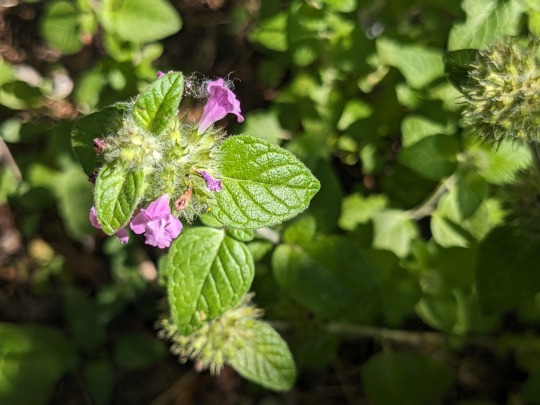
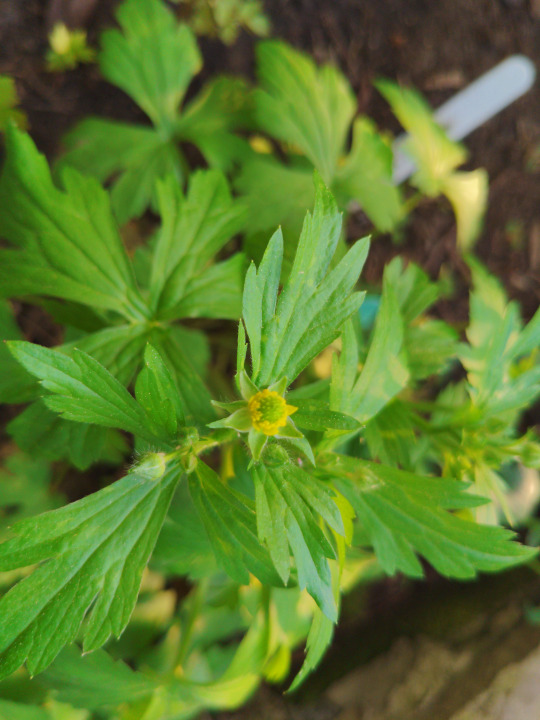


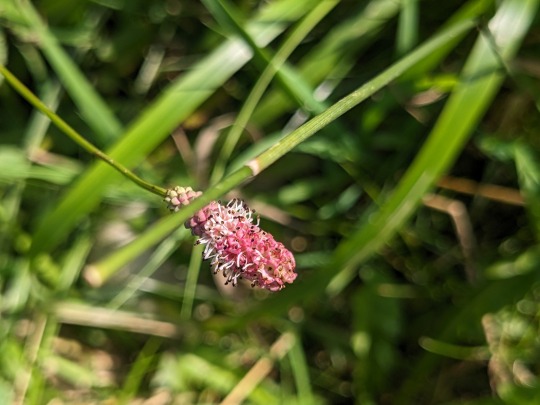
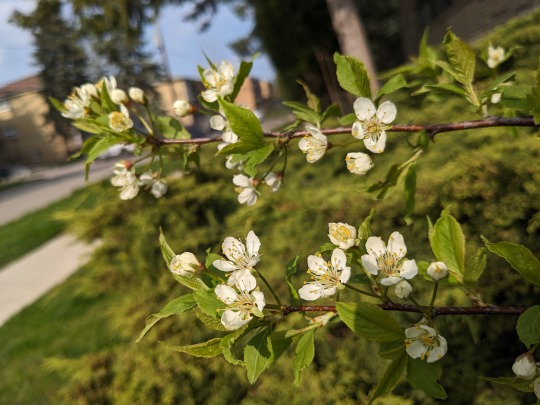

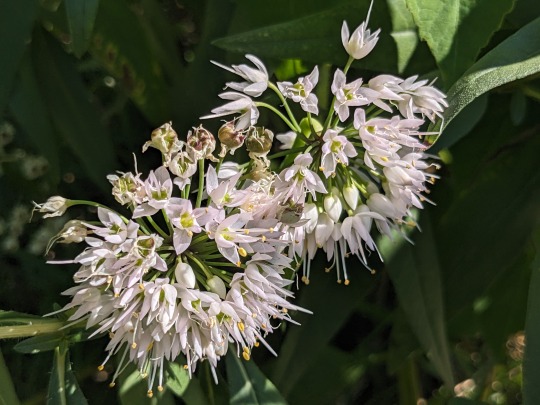
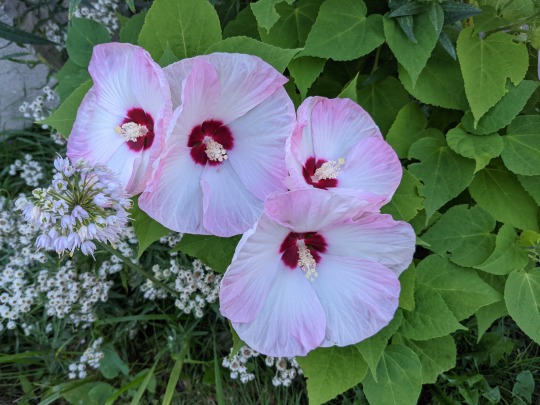

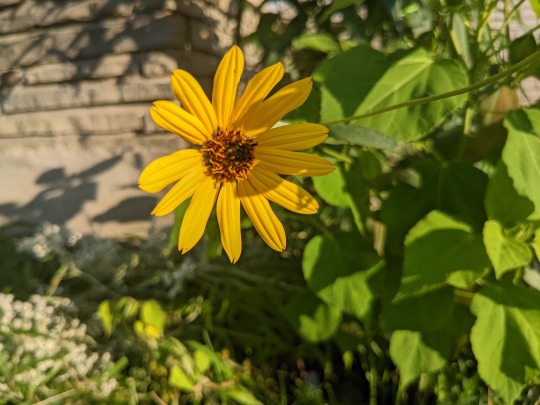

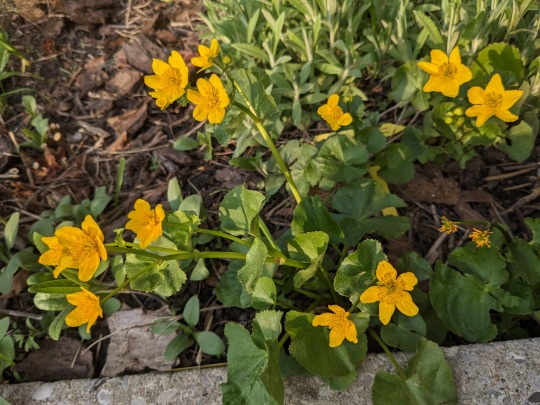


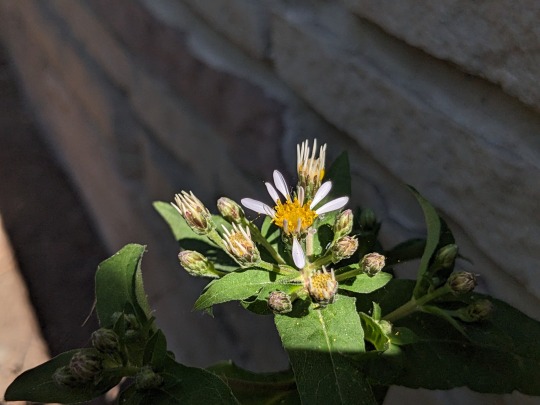

In order of appearance:
061. Wild Basil (Clinopodium vulgare) Didn't do so well the last place I had her in, but she seems happy in this spot, so fingers crossed.
062. Crested Iris (Iris cristata) Not pictured as she hasn't flowered yet.
063. Smallflower Buttercup (Rancunculus abortivus) Not much to look at compared with other buttercups but one of the only native buttercups with (limited) edible uses.
064. Smooth Solomon's Seal (Polygonatum biflorum) Not pictured as she hasn't flowered yet. Soon, hopefully!
065. False Solomon's Seal (Maianthemum racemosa) Not pictured as she hasn't flowered yet, but she's growing well so hopefully next year.
066. Blisterwort (Ranunculus recurvatus) I didn't plant that. She just turned up last year. Not pictured as I haven't got any pictures yet.
067. Fairy Spuds (Claytonia virginica) Not pictured as she hasn't flowered yet. She's a wee little spud in the ground.
068. Flowering Dogwood (Cornus floridus) Not pictured as she hasn't flowered yet but she is slowly spreading out.
069. Plantain-Leaf Sedge (Carex plantaginea) Not pictured as I haven't got pictures yet. I should. It's a neat plant. Evergreen, too!
070. Virginia Bluebells (Mertensia virginica) One of the prettiest plants I've ever seen, from the shape and texture of the leaves to the purplish pink buds to the bright blue bell-shaped flowers. They're spring ephemerals, though, so they're long gone by now. But will emerge next spring!
071. Evening Primrose (Oenothera biennis) Only lives for two years and reseeds itself. It's a common weed along sidewalks, but its flowers glow yellow in the evening and often remain in bloom at night.
072. Squirrel Corn (Dicentra canadensis) Not pictured as she hasn't flowered yet. The leaves are really cute, though.
073. Large Toothwort (Cardamine maxima) Not pictured as she hasn't flowered yet.
074. Wintergreen (Gaultheria procumbens) Not pictured as I haven't got any pictures yet.
075. Great Burnet (Sanguisorba officinalis) A cultivar, not sure which one. I'll get the wild type if/when I can.
076. American Plum (Prunus americana) I was not expecting her to flower this year! Hopefully she will next year too, and without aphids this time so I can have some plums. :)
077. Smooth Aster (Symphyotrichum laeve) So like I said, I do think New England asters are the prettiest of this genus, but smooth asters are very nice in their own way. Tender bluish leaves, and delicate light purple flowers.
078. Sweet Grass (Hierochloe odorata) Not pictured as I haven't got any pictures yet. She only flowered one year. Hasn't since. I won't miss a photo next time.
079. Nodding Onion (Allium cernuum) What's better than pretty flowers? Tasty pretty flowers!
080-081. Swamp Rose Mallow (Hibiscus moscheutos) Two different cultivars and the red one has died, but I did get my hands on the wild type! That will hopefully bloom this year.
082. Stiff Sunflower (Helianthus pauciflorus subrhomboideus) Holds her own against the much more aggressive Nuttall's sunflower. Sometimes called beautiful sunflower. I don't know how one decides which species of a very showy genus gets that name, but I guess she won out.
083. Pearly Everlasting (Anaphalis margaritacea) Another one that was hard to choose a photo of. You just hardly believe they're real!
084. Marsh Marigold (Caltha palustris) I planted her where there's a drip from the eavestrough so she can get very wet when it rains. :) She is not a marigold but instead part of the buttercup family.
085. Nuttall's Sunflower (Helianthus nuttallii) Whenever I am expressing frustration about sunflowers, it is almost always this species. lol Very beautiful but very aggressive.
086. Larkspur Violet (Viola pedatifida) Not pictured as she hasn't flowered yet.
087. White Turtlehead (Chelone glabra) Not pictured as she hasn't flowered yet.
088. Small Sundrops (Oenothera perennis) Not quite as intensely yellow as some of her relatives but still very bright.
089. Bigleaf Aster (Eurybia macrophylla) You generally grow her for foliage rather than her flowers, but flowering she is! Very drought-tolerant, but spreads more readily in less harsh conditions.
090. Bride's Feathers (Aruncus dioicus) Southern Ontario and surrounding area's evolution really went off on the lacy white flowers, and this species' flowers might be the laciest of them all.
#blackswallowtailbutterfly#my photos#photography#my garden#garden flowers#native plant gardening#native flowers of Carolinian Canada and USA#Viola sororia#Rancunculus abortivus#Mertensia virginica#Oenothera biennis#Sanguisorba officinalis#Prunus americana#Symphyotrichum laeve#Allium cernuum#Hibiscus moscheutos#Helianthus pauciflorus subrhomboideus#Anaphalis margaritacea#Caltha palustris#Helianthus nuttallii#Oenothera perennis#Aruncus dioicus
11 notes
·
View notes
Text

Wild Basil
Clinopodium vulgare
Lamiaceae
Photograph taken on July 21, 2023, at Mono Cliffs Provincial Park, Mono, Ontario, Canada.
#wildflowers of southern ontario#wild basil#basil#Clinopodium vulgare#Clinopodium#Lamiaceae#Mono#Mono Cliffs#Mono Cliffs Provincial Park#provincial park#Ontario#Canada#wildflowers#wildflower#purple#violet#flora#flowers
15 notes
·
View notes
Photo

Clinopodium vulgare, wild basil, is a species of flowering plant in the Lamiaceae family.
8 notes
·
View notes
Text
21 au 27 mars 2022
I started sowing seeds this week, so I can plant them out in the autumn. The mornings were very cold so I spent the first hour or two sowing seeds in the glasshouse. Then I continued raking the soil for the new meadow. This was tough work. Couli and I just kept raking and clearing the biggest stones, cut roots and clumps of grass. We finished Tuesday. Tuesday afternoon I pulled a roller over the entire site, twice. Then I set up sprinklers around the area so they would be ready to go immediately after sowing.
Wednesday, late morning, I sowed the wildflower meadow. Here are the seeds before being mixed up and mixed with sand to help with a more even distribution.
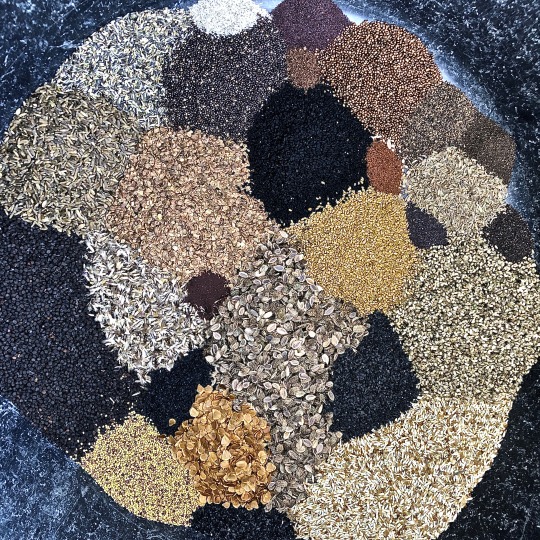
Here are the seeds all mixed together.
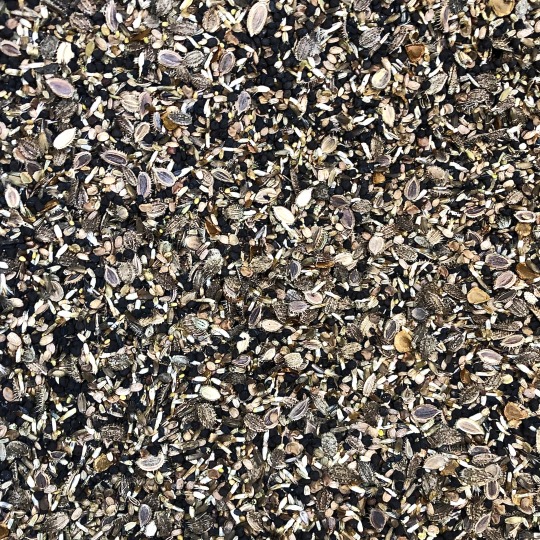
This is the mix:
Achillea millefolium
Agrostemma githago
Allium schoenoprasum
Allium vineale (syn. Allium sphaerocephalum)
Carum carvi
Clinopodium nepeta (syn. Calamintha nepeta)
Campanula persicifolia
Catananche caerulea
Centaurea cyanus 'Blaue Gefüllte'
Centaurea scabiosa
Centaurium erythraea
Dianthus carthusianorum
Galium verum
Knautia arvensis
Lilium martagon
Nigella sativa
Origanum vulgare
Orlaya grandiflora
Ornithopus sativus
Papaver rhoeas
Phacelia tanacetifolia
Pimpinella saxifraga
Rhinanthus minor
Salvia pratensis
Salvia sclarea
Scabiosa columbaria
Trifolium rubens ( or is it Trifolium alpestre ? Time will tell.)
Verbascum blattaria (syn. Verbascum blattaria f. albiflorum)
Couli will take care of irrigation while I’m on holiday. It is very frustrating that Michel delayed this entire project by over a week. I sent a strongly worded message regarding his bullying. Thankfully it is done and I can go away knowing it is in good hands with Couli. Things should take at least a week to germinate by which time I’ll be back.
Wednesday after work, I took the train to Ventimiglia. I couldn’t start my holiday soon enough. I started having problems using my credit card when I ordered my Uber, which I just found a bit strange and thought not much of it until it was refused in the evening when I tried to pay for my hotel room. The place I chose to stay was very close to the train station for my 06.40 train to Rome the next morning. Coincidently, the restaurant André and Denis recommended was adjacent and owned by the cousin of the person I rented my room. The food was delicious. It also seems to be a bit of a gay gathering spot; all the other people in the restaurant were male couples.
Before bed, I sent an email to my bank and was going to ring them while on the train Thursday. I woke up in the middle of the night worrying and discovered a way to send a message via the app. I received a phone call within an hour and we went through about a dozen fraudulent charges. I was shocked. My card had to be cancelled. I was now on holiday without my main credit card. Thankfully, Daniel, who I was visiting in Rome, lent me some money and I had brought my Monzo card, so I transferred money around so I could use it.
It was so nice to spend four days in Rome with Daniel. We’ve been friends since 1994.

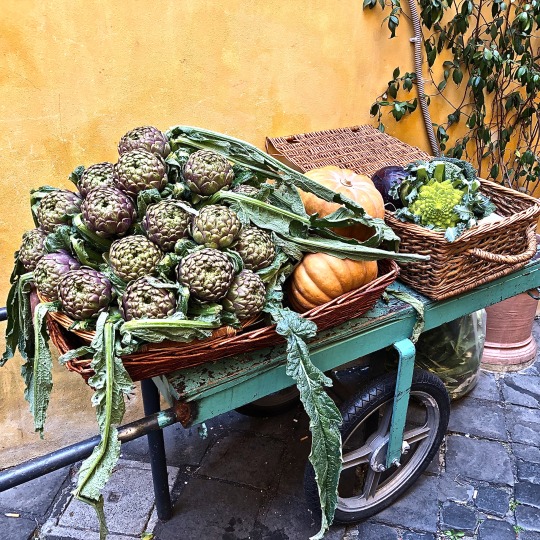
We ate very well and enjoyed just wandering around the quieter parts of Rome.

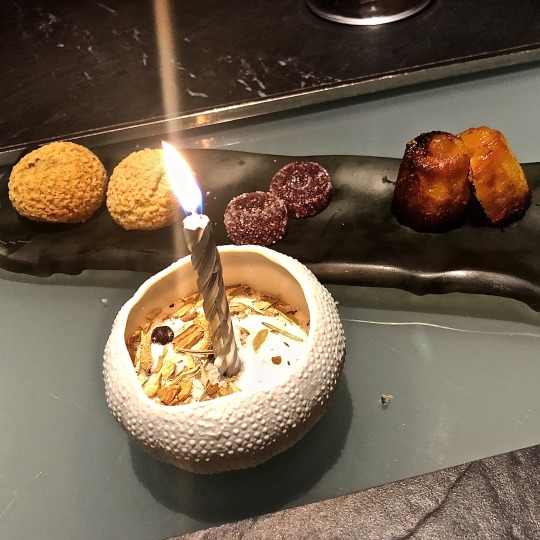
Plant of the week
Boraginaceae Phacelia tanacetifolia Benth.

common name(s) - lacy phacelia, blue tansy, purple tansy, fiddleneck; français : phacélie à feuilles de tanaisie; Deutsch : Büschelblume
synonym(s) - Phacelia commixta Greene; Phacelia tanacetifolia var. cinerea Brand; Phacelia tanacetifolia var. genuina Brand; Phacelia tanacetifolia var. pseudodistans Brand; Phacelia tanacetifolia f. staminea Brand; Phacelia tanacetifolia var. tenuifolia Torr.; Phacelia tanacetifolia subvar. tenuisecta Brand; Phacelia tripinnata Fisch., C.A.Mey. & Avé-Lall.
conservation rating - none
native to - California
location - Domaine de l’Orangerie
leaves - deciduous fern-like pinnately cut, sometimes rather grey-green; mostly divided into smaller leaflets which are deeply and intricately cut into toothed lobes, giving them a lacy appearance
flowers - abundant, densely set soft blue or lavender-blue in terminal, curved cymes in summer; dense and hairy inflorescence is a one-sided curving or coiling cyme of bell-shaped flowers in shades of blue and lavender; just under a centimetre long and has protruding whiskery stamens
fruit - seeds are "negatively photoblastic", or photodormant, and will only germinate in darkness
habit - robust winter annual of variable height, 200mm to 1,200mm tall and 500mm wide
habitat - most common in the deserts of southern California at elevations below 1,500m, but may be occasionally found at much higher elevations
pests - generally pest-free
disease - generally disease-free
hardiness - to -10ºC (H4)
soil - well-drained chalk, loam or sand
sun - full sun
propagation - seed; self-seeds freely
pruning - none required
nomenclature - Boraginaceae - borago - shaggy-coat, burra with feminine suffix (the leaves); Phacelia - from Greek meaning bundle, in reference to the clustered flowers; tanacetifolia - with leaves resembling those of Tanacetum
NB - is used outside its native range in agriculture as a cover crop, a bee plant, an attractant for other beneficial insects, as a green manure and an ornamental plant; is planted in vineyards and alongside crop fields, where it is valued for its long, coiling inflorescences of nectar-rich flowers which open in sequence, giving a long flowering period; is a good insectary plant, attracting pollinators such as bumblebees and honey bees; also attractive to hoverflies (family Syrphidae), which are useful as biological pest control agents because they eat aphids and other pests.
References :
Gledhill, David, (2008) “The Names of Plants”, fourth edition; Cambridge University Press; ISBN: 978-0-52168-553-5
IUCN [online] http://www.iucnredlist.org/search [10 Apr 22]
Plants of the World [online] https://powo.science.kew.org/taxon/urn:lsid:ipni.org:names:432789-1 [10 Apr 22]
Royal Horticultural Society [online] https://www.rhs.org.uk/plants/23945/phacelia-tanacetifolia/details [10 Apr 22]
Wikipedia [online] https://en.wikipedia.org/wiki/Phacelia_tanacetifolia [10 Apr 22]
World Flora Online [online] http://www.worldfloraonline.org/taxon/wfo-0000465176 [10 Apr 22]
0 notes
